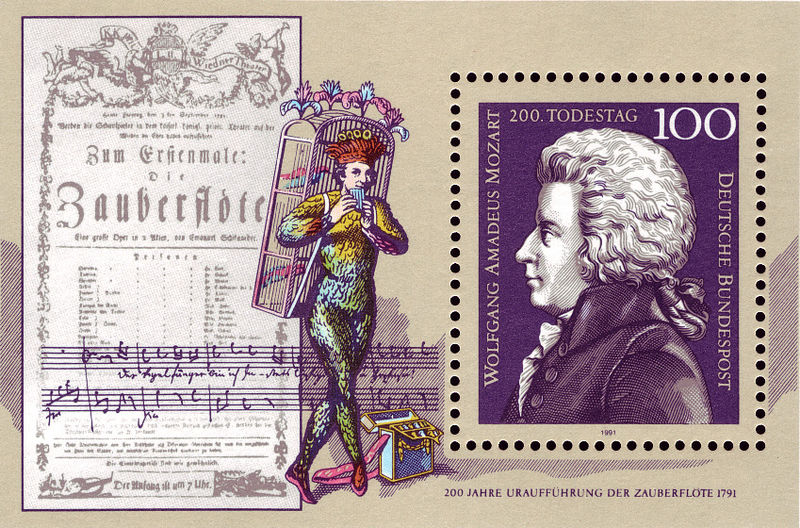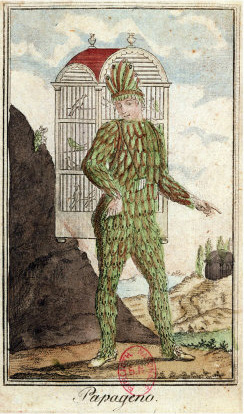Music with Ease > Opera Before 1800 > The Magic Flute (Mozart)
The Magic Flute
(German title: Die Zauberflöte)
An Opera by Wolfgang Amadeus Mozart
This was Mozart’s last opera. It was produced at Vienna on September 30, 1791, and on December 5 the master passed away. He wrote it to oblige his old friend Schickaneder, the theatre manager, who prepared the libretto, and who requited the favour by selling the score to other managers, contrary to a promise made to the composer. The text is disjointed, and full of improbabilities and absurdities. Yet it is undeniably adapted for the stage. Goethe, who admitted its inanities, and himself contemplated a continuation of the libretto, declared that "the author had the most perfect knowledge of the art of contrast and a wonderful knack of introducing stage effects."

1991 German commemorative postage stamp block celebrating 200 years since the first production of Mozart's The Magic Flute in 1791. Depicts a 1791 theater flyer for the opera, a snippet of Mozart's music (in his own handwriting), Papageno (the bird catcher), and a portrait of Mozart.
It was at first founded on a fable by Wieland, but had to be altered when the same plot appeared in a rival contemporary play. Moreover, it was arranged to display some of the manager’s old stage properties. Under these conditions it could hardly be expected that "The Magic Flute" would attain the high level of the two Da Ponte plays. Another consideration which should be noticed has militated against its continued popularity. The signs of Free-masonry in the libretto are not much observed now, but they demand attention for the proper understanding of the work. In 1791 the Emperor Leopold had opposed the Freemasons, so that the public followed allusions to that craft which have now lost their special point and meaning. Ferdinand David said that no one who was not a Freemason could thoroughly appreciate the opera; and he instanced the grand chords played by the trombones at the end of the first part of the Overture and in the first scene in the Second Act: "a symbol which no Freemason could possibly fail to understand." Mozart himself was a Freemason and so was his librettist.
The story is based on circumstances connected with the mysterious worship of Isis, the deity of the ancient Egyptians. Its action is consequent upon Sarastro, the high priest of the Temple of Isis, having borne away Pamina, the daughter of Astrifiammante, the wicked Queen of Night, from her mother in order that she may be trained in the ways of virtue and wisdom. Tamino, a handsome Egyptian prince is saved from a monstrous serpent by the Queen’s servants. They show him a portrait of Pamina, and he falls in love with the unknown original. He is told the story of her having been stolen by Sarastro, and he vows to rescue. her.
Before starting he is presented with a magic flute, by which he is enabled to give alarm and invoke assistance in cases of peril; while Papageno, the silly bird-catcher, who accompanies him, is furnished with certain musical instruments which, when played, transform anger into mirth and provoke a desire for dancing. Developments need not to be detailed. It is only necessary to say that Tamino, instead of bringing back Pamina, becomes a noviate in the Temple; meets Pamina there; goes through, like her, a severe testing probation; is ultimately proved worthy, and marries Pamina, while his companion, Papageno, also finds a mate.
"The Magic Flute," like its predecessors, is true to nature from the first note to the last, and the hand of the master is as clearly discernible in the tinkle of Papageno’s glockenspiel as in the grandest contrapuntal triumph of the last finale. Objection has sometimes been taken to the florid passages of the Queen of Night’s aria, "Gli angui d’inferno," as being opposed to sense and good taste. A French critic is probably right, however, in his opinion that Mozart did not write these passages for mere display, but that he had a dramatic intention, namely by them, and especially by the high notes, to give to the Queen une intensite fantastique. Beethoven is said to have considered this Mozart’s greatest opera, because in it were to be found nearly every species of music from the lied to the chorale and fugue.
The opera was such a success after its first production in September 1791, that by October 12, 1795, it had been performed no fewer than two hundred times. It was first staged in Paris, where it has recently been revived in 1801, and in London in 1811. Though it was given by the students of the Royal College of Music, under the direction of Sir Charles Stanford, at the Lyceum in 1899, there has been no public performance in London since 1892 -- at the Olympic Theatre, under Lago’s management. The neglect is no doubt due in a measure to the causes already suggested; but more particularly perhaps to the fact that special singers are required for the Queen of Night and Sarastro arias. Mme. Tetrazzini is probably the only living artist who could do full vocal justice to the role of the Queen.
Share this page:
MAGIC FLUTE POSTER

Emanuel Schikaneder, the librettist of Mozart's opera, Die Zauberflöte, shown performing in the role of the silly birdcatcher, Papageno. The object on his back is a birdcage.
Size: 18 in x 24 in.
Giclee Print.
Buy at AllPosters.com
Music With Ease | About Us | Contact Us | Privacy | Sitemap | Copyright | Terms of Use © 2005-23 musicwithease.com. All Rights Reserved. |
